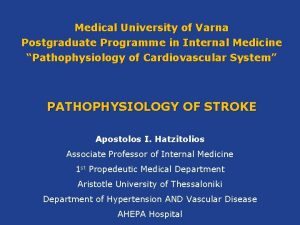Imaging Characteristics of MethamphetamineAssociated Ischemic Strokes Nhayoung Hwang

- Slides: 1

Imaging Characteristics of Methamphetamine-Associated Ischemic Strokes Nhayoung Hwang 1, Sandeep Walia, MD 2, Kwan Ng, MD, Ph. D 3, Alan Yee, DO 3 University of California, Davis School of Medicine 1, Department of Neurology, Stanford University 2, Department of Neurology, University of California, Davis 3 INTRODUCTION Methamphetamine (meth) is a highly addictive stimulant with harmful effects that lead to cardiovascular disease and stroke. 1 Rates of meth use have been growing with an estimated 24 million users worldwide as of 2015. 2 Despite a strong association between meth use and increased cerebrovascular risk, 3 detailed descriptions of clinical and neuroradiologic characteristics in larger cohorts are lacking. Meth use in the United States 4 Table 1. Demographics, N=90 n Age, average in years 55 Stroke Etiology % Sex Male 62 69 Female 28 31 17% 25% Race/Ethnicity 42 47 Small vessel Black/African American 22 24 Other etiology Hispanic/Latino 7 8 American Indian/Native American 0 0 Asian 7 8 Pacific Islander 1 1 Other 11 12 27% • Meth-associated acute ischemic stroke is a multicultural problem • Although small vessel vasculopathy is suspected in most, a significant proportion is due to proximal embolic sources • Clinical outcome was poor; long-term care required in most and nearly 1 in 6 died during their hospitalization • Next steps of the study include comparing this sample with non-meth-associated ischemic strokes to identify significant differences in patient and imaging characteristics. Figure 2. Distribution of lesions PCA: 26% Sacramento, CA Multiple: 30% • Single-center retrospective analysis • Consecutive adults admitted in 2016 to 2019 for acute ischemic stroke and meth-positive toxicology Patient Characteristics • Total of 90 patients • Nearly half from underrepresented minority ethnic/racial groups Figure 1. Affected vascular territories Table 2. Acute ischemic strokes, N=90 n % More than one lesion 51 57 Bilateral 28 31 Purely cortical 6 7 Purely subcortical 28 31 Purely brainstem 4 4 REFERENCES 1. Figure 3. Subcortical lesion distribution Patient Discharge Dispositions Patient Example Multiple subcortical strokes, one in the right pons, another in the left trigone region www. Poster. Presentations. com 3. Table 3. Disposition, N=92* n % Home 48 53 Rehab 8 9 SNF 12 13 Acute care/outside hospital 8 9 Death 14 15 Left against medical advice 2 2 *Two patients were admitted twice for separate strokes RESEARCH POSTER PRESENTATION DESIGN © 2012 2. Case courtesy of Assoc Prof Frank Gaillard, Radiopaedia. org, r. ID: 37605 Patient A RESULTS 26% CONCLUSIONS MCA: 71% OBJECTIVE Cryptogenic Figure 4. TOAST Criteria ACA: 10% MATERIALS & METHODS Cardioembolic White Lesion Characteristics To examine the clinical and neuroimaging characteristics in patients with acute ischemic stroke and concurrent methamphetamine use. Large vessel 4% 4. National Institute on Drug Abuse. (2019). Methamphetamine. Retrieved from https: //www. drugabuse. gov/drugs-abuse/methamphetamine Chomchai, C. , & Chomchai, S. (2015). Global patterns of methamphetamine use. Current Opinion in Psychiatry, 28(4), 269 -274. doi: 10. 1097/yco. 0000000168 Westover, A. N. , Mcbride, S. , & Haley, R. W. (2007). Stroke in Young Adults Who Abuse Amphetamines or Cocaine. Archives of General Psychiatry, 64(4), 495. doi: 10. 1001/archpsyc. 64. 4. 495 PBS. (2006, February). Map: The Reach of Meth. Retrieved from https: //www. pbs. org/wgbh/pages/frontline/meth/map/ ACKNOWLEDGEMENTS Thank you to Dr. Alan Yee for his mentorship and guidance as well as Dr. Sandeep Walia, Dr. Miguel Ruvalcaba, Dr. Kwan Ng, and the UC Davis Department of Neurology without whom this project would not be possible.

